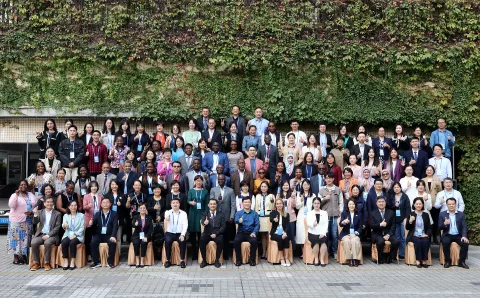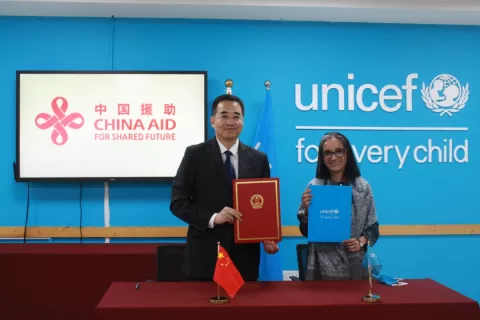Millions of children and mothers' lives saved in China since 1990
Focus now on ending all preventable deaths by 2030, and reaching children and women missing out
- Available in:
- 中文
- English
BEIJING, 26 October 2015 – Millions of children lives have been saved in China by expanding access to quality primary health care across the country over the last 20 years. The rate of mortality among China's children under five dropped by 80 per cent from 79.2 per 1,000 in 1991 to 11.7 per 1,000 live births in 2014 and infant mortality dropped to 8.9 per 1,000 live births, a drop from more than 50.2 per 1,000 in 1991. Significant progress has been made in reducing the number of women dying during childbirth. In 2014, the maternal mortality rate was 21.7 per 100,000 which was 76 per cent lower than in 1990.
China's dramatic success in meeting the Millennium Development Goal numbers 4 and 5 is the focus of China's Countdown Meeting, a global review mechanism to measure progress in maternal, new-born and child health. The meeting of 350 provincial experts and experts from the National Family Planning and Health Commission along with 50 international experts is intended to take stock and look into the new health indicators agreed to under the Sustainable Development Goals that will define the international development agenda till 2030.
As other countries seek to learn from China's success in expanding primary health care services, the conference will focus on the key ingredients that have contributed to the reduction in mortality and also determine how to tackle inequality and improve health coverage for poor families and those in remote rural areas.
In his remarks to the opening session of the forum, Qin Geng, Director-General of the Department of Maternal and Child Health at the National Health and Family Planning Commission, said China has made significant progress in improving maternal and child health, but in the meantime also faces many challenges. He said looking into 2030, China will continue expanding access to equitable maternal and child health services, reducing preventable maternal and child mortality, improving child nutrition, preventing mother-to-child transmission of HIV, improving family planning and reproductive health services, as well as further strengthening international cooperation. Through these efforts, China will make sure the maternal and child health-related targets outlined in the post-2015 development agenda can be met in the country.
“We must commend the Government of China for commitment to maternal and child health over the last three decades and their strong commitment to the UN's Every Women, Every Child Initiative,” said Rana Flowers, UNICEF Representative to China. “The dramatic success over a relatively short period of time is an indication how strong political commitment along with targeted policies, accompanied by financing, as well as an investment in public health infrastructure and human resources, have paid off. They have translated into lives saved and healthier mothers and babies. UN agencies, especially UNICEF, UNFPA and WHO are proud to have worked with the Government to contribute to this significant drop in mortality.”
After the World Summit for Children in 1990, China invested in strengthening policy and legislation for setting up well-functioning health system that would expand coverage across the country. This included setting up the National Program for Women's Development and the National Action Plan for the Development of Children in China, specifically tasked to safeguard the health of mothers improve the quality of care for new-borns and infants. This guided efforts that included:
- Promoting antenatal health care services and introducing folic acid supplements for pregnant women.
- Scaling up hospital delivery to universal coverage levels.
- Expanding coverage of rural and urban medical insurance systems that since 2003 has grown from 80 million rural dwellers to cover 833 million people in 2009.
- Expanding access to basic public health services including for children 0 to 6 years old, and for women in poor areas.
- Introducing universal child immunization in 1978, which had a dramatic impact in reducing vaccine preventable deaths such as from polio, measles, tetanus, diphtheria and hepatitis B. In 1999 China was declared polio free. In 2008, the National Immunization Programme was expanded to protect children against 12 preventable diseases. In 2012,maternal and neonatal tetanus was officially eliminated.
- Promoting knowledge on reproductive health among adolescents and youth.
“At the same time that it has made incredible progress in lifting hundreds and millions of people out of poverty, China has taken huge strides in reducing the number of women who die giving birth. Tens of thousands of mothers' and babies' lives have been saved, and children's lives immeasurably improved, as a result. But there is much, much more to do. Every mother that dies during childbirth is one too many. Every neonatal death represents a life we should be trying to save,” said Dr Bernhard Schwartländer, WHO Representative in China.
As part of the new 2030 global development agenda, outlined in the recently adopted 17 Sustainable Development Goals at the United Nations in September, health remains a major priority. With a focus on leaving no one behind, the priority is to extend health life expectancy by expanding universal health coverage and accelerating progress in reducing stillbirths, new-born, child and maternal mortality by ending all preventable deaths by 2030. It also includes new targets linked to injuries and non-communicable diseases as well as strengthening health systems, building better social safety nets, and ensuring that every new-born is counted and registered.
Despite China's enormous progress, with an estimated 16 million babies born each year, the absolute number of children under five, especially those dying in the few months of life from preventable diseases, is still large at 200,000, with the majority born in remote rural areas without adequate care and support.
The meeting will focus on areas where China can do more to further improve maternal, new-born and child mortality, prevent stillbirths, and learn from global best practise, especially in tackling inequity in access and improve quality of basic health services. It is hoped the outcomes can help contribute to the commitments outlined in the country's 13th National Development plan as well as the Sustainable Development Goals.
Areas which will be highlighted during the meeting that need to remain a priority include:
- Improving quality in reproductive health services for women and adolescents and in maternal health. Attributes of quality include not only expanded access to care and its effectiveness, but also safety, equitability, efficiency, privacy and confidentiality.
- Ensuring focus on high impact child survival interventions. Compared to the progress made in maternal survival, reductions in child deaths are lagging behind, and an estimated 200,000 child deaths can still be prevented each year. Pneumonia is one of the major causes of mortality in the post-neonatal period.
- Addressing urgently the declining breastfeeding rates to improve nutrition and mortality. Although strong Government commitments to breastfeeding, coverage is dropping, and rampant marketing of breastmilk substitutes continues to undermine efforts to increase exclusive breastfeeding rates.
- Stepping up efforts in reducing maternal and child anemia by improving nutrition and expanding micronutrients supplements. Anaemia rates in pregnancy in particular among the poorest rural women are high and put women at unnecessary risk of death from maternal haemorrhage around delivery. Meanwhile, China is implementing a supplementation programme with so called Ying Yang Bao (an in-home food fortificant), focusing on national poverty counties.
- Addressing migrant health needs.Migrants, especially migrantchildren,have fewer opportunities to access health care services and pay more when they do.
- Providing health coverage to the youngest children and migrants. UNICEF research demonstrated that one third of China's children under five remain uninsured. Infants and migrant children are particularly vulnerable and around two times less likely to be insured than adults.
- Ensuring universal birth registration. The peak of under-five mortality is in the first week of life, long before the average Chinese child receives a birth certificate, let alone is registered. This means access to life saving health service is denied when they are needed most. It also means an unnecessary barrier to access early child development services, which impacts on future productivity potential.
- Encouraging multisectoral efforts to improving determinants of reproductive, maternal, new-born, child and adolescent health. Greater focus on equity and social determinants of health are much needed given that drivers of disparity lie mostly beyond the health sector.
About the World Health Organization
WHO is the directing and coordinating authority for health within the United Nations system. It is responsible for providing leadership on global health matters, shaping the health research agenda, setting norms and standards, articulating evidence-based policy options, providing technical support to countries and monitoring and assessing health trends.
Media contacts
About UNICEF
UNICEF works in some of the world's toughest places, to reach the world's most disadvantaged children. Across 190 countries and territories, we work for every child, everywhere, to build a better world for everyone. For more information about UNICEF and its work for children visit www.unicef.org.
| Visit UNICEF China website: www.unicef.cn Follow us on Sina Weibo: http://weibo.com/unicefchina Tencent Weibo: http://t.qq.com/unicef Wechat: unicefchina |





